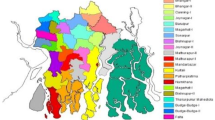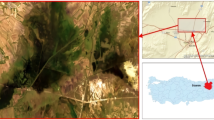Abstract
The Sundarbans is one of the productive mangrove wetland ecosystems in the Ganges-Brahmaputra delta in Bangladesh. The delta is undergoing rapid ecological changes due to human activity. In the present study, surface water salinity data from 13 rivers of the Sundarbans were collected in order to investigate the saline water intrusion in the mangrove wetlands. Results demonstrate that saline water has penetrated the upstream area as river water salinity has increased significantly in 1976 compared to the year 1968. The soil and river water salinity data also shows that it has crossed the water salinity threshold line in most parts of the Sundarbans wetlands. These observations are due to the construction of Farakka Barrage in 1975, which reduced the water discharge of the Ganges River from 3700 m3/s in 1962 to 364 m3/s in 2006. The shortage of freshwater discharge to the deltaic area is trailing active ecosystems function, especially in the dry season in the south western region in Bangladesh. The objective of this study is to understand and analyze the present degraded mangrove wetland ecosystems and their negative impacts. The findings of this study would contribute to the formulation of the mangrove wetland ecosystems management plan in the Ganges delta of Bangladesh.
Similar content being viewed by others
References
Anon (1995). Integrated resource management plan of the Sundarbans reserved forest vol 1. Draft final report of FAO/UNDP project BGD/84/056-integrated resource development of the Sundarbans resource forest, Khulna, Bangladesh, 385
Bagchi K G (1944). The Ganges Delta. Calcutta: Calcutta University Press, 1–25
Barbier E B (1993). Sustainable use of wetlands valuing tropical wetland benefits: Economic methodologies and applications. The Geographical Journal, 159(1): 2–52
Begum K (1987). Tention Over the Farakka Barrage _a Techno Political Tangle in South Asia. Dhaka: University Press Limited, 279
Blower J (1985). Sundarbans forest inventory project, Bangladesh. Wildlife conservation in the Sundarbans. Project report 151. Overseas Development Administration, Land Resources Development Centre, Surbition, UK, 39
Coleman J M (1974). Deltaic Evolution, the Encyclopedia of Geomorphology. In: Fairbridge R W (ed.,), New York, USA, 252–255
Colugh B F (1985). Factors Regulating Mangrove Ecosystem Primary Productivity. Proceedings of the UNDP/UNESCO Regional Project RAS/79/002 Workshop on Mangrove Ecosystem Dynamics, Papua New Guinea. 79–85
EGIS-Environmental and Geographical Information Studies (2000). Bangladesh Water Development Board-Environmental baseline of Gorai River restoration project. (EGIS-I, EGIS-II, and EGIS-III). Environment and GIS support project for water sector planning, Ministry of Water Resources, Government of the Peoples Republic of Bangladesh, EGIS, Dhaka, 190
Elahi K M, Das S C, Sultana S, et al (1998). Geography of Coastal Environment: a Study of Selected Issues. In: Bayes A, Mahammad A, Bangladesh at 25, an analytical discourse on development. Dhaka: The University Press Limited, 336–368
Hasna J M, (1995). Women for Water Sharing. Dhaka: Academic Publishers, 1–136
Hassan M, Rahman M S, Haider Z M, et al (2001). Some Facts and Observations Related to Salinity and the River System of the Sundarbans Mangrove Forest. Paper presented at 1st national conference on the Sundarbans at Khulna University. 14–16 February, Khulna. Bangladesh, 1–4
Husain K Z (1995). The Farakka Catastrophe Reflectiona. In: Hasna J M, (ed.,) Women for Water Sharing. Dhaka: Academic Publishers, 71–72
Hussain Z, Acharya G (1994). Mangrove of the Sundarbans, Vol 2, Bangladesh. IUCN-Bangkok. Thailand: Dyna Print Ltd, 1–209
Islam S N (2003). Sustainable Eco-tourism as a Practical Management Policy. Dhaka: AH Development Publishing House, 34–47
Islam S (ed.,) (2006). Banglapedia: Ganges-Padma River System, National Encyclopaedia of Bangladesh, Asiatic Society of Bangladesh. Asiatic civil Military Press, Dhaka. http://www. banglapedia.org/English/Index.htm
Joseph P S (2006). The Environmental Management Do Better Supply of Fresh Water in Transboundary River: The Ganges Could Run Dry. In: Perez J G (ed.,). Proceedings of III International Symposium on Transboundary Water Management-Overcoming Water Management Boundaries. Ciudad Real: Universidad de Castilla-La Mancha, 1–101
Katebi M N A (2001). Sundarbans and Forestry. In: Haider (ed.,). Cyclone’91-An Environmental and Perceptional Study. Dhaka: BACS, Dhaka, 79–100
Khan S M, Haq E, Huq S, et al (1994). Wetlands of Bangladesh. Bangladesh Centre for Advanced Studies (BCAS). Dhaka: Holiday Printers Limited, 2–57
Miah M (2003). Hydro-politics of the Farakka Barrage. http://www.sdnpbd.org/river-basin/bangla
Nishat A (2006). Water at Farakka Barrage in 2006. http://www.ajkerkagoj.com/2006/April 08/Dhaka
Rob M A (1998). Changing morphology of the coastal region of Ganges Delta. Oriental Geographer, 41(2), 1997. Dhaka: Dhaka University, 49–64
Seidensticker J, Hai M A (1983). The Sundarbans Wildlife Management Plan, Conservation in the Bangladesh Coastal Zone. IUCN, Gland, Switzerland, 1–20
UN ESCAP-United Nations/Economic and Social Cooperation for Asia and the Pacific (1988). Coastal environmental management plan for Bangladesh. UNESCAP, Bangkok, Thailand, 2–25
Zube E H (1986). Landscape values: History, Concepts and Applications. In: Smardon P, and Felleman (eds.,). Foundations for visual project analysis. New York: John Wilay & Sons, USA, 4–19
Author information
Authors and Affiliations
Corresponding author
Rights and permissions
About this article
Cite this article
Islam, S.N., Gnauck, A. Mangrove wetland ecosystems in Ganges-Brahmaputra delta in Bangladesh. Front. Earth Sci. China 2, 439–448 (2008). https://doi.org/10.1007/s11707-008-0049-2
Received:
Accepted:
Published:
Issue Date:
DOI: https://doi.org/10.1007/s11707-008-0049-2




